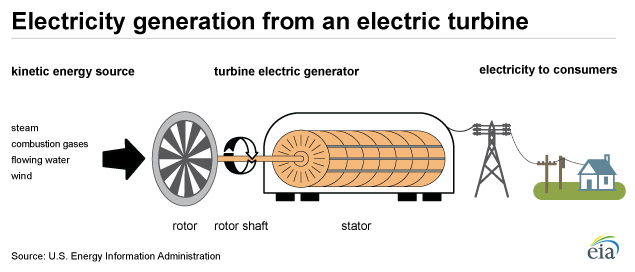
Electricity’s journey to your plug is very long, but occurs at astonishing speed. It is not magic; it is not science fiction. It is a step-by-step process which explains many of the doubts that arise with regard to the electricity sector:
As we said earlier, in order to generate electricity, we need to release the energy contained in primary materials. How do we do this? It depends entirely on the type of electricity plant we are talking about:
1. Conventional cycle thermo-electric plants (coal, diesel oil and natural gas): energy is liberated by burning coal, natural gas or diesel oil. As they burn, they are used to heat a tank of water. That water transforms into steam, which is used to drive a turbine. It is this movement which generates electricity, by means of an alternator, which turns the mechanical energy into electrical energy. Finally, the steam passes through a condenser, turning back into liquid water, and starting the cycle anew.
2. Nuclear power plants: the heat released by nuclear fission in a reactor is used to heat large quantities of high-pressure water. The resulting steam produces electricity as it passes through a turbine connected to a generator. The fuel used tends to be uranium.
3. Geothermal power plants: the system is similar to the previous ones (water is heated to create steam which drives a turbine), but in this case, we use the natural heat within the planet through pipelines in the subsoil.
4. Biomass plants: in this case, heat is generated by burning organic material, be it plant matter or any kind of waste (animal, industrial, agricultural and urban waste products).
5. Hydro-electric plants: these plants do not require heat, as these are the evolved version of the windmills of old. What they do use is a significant water drop to move a hydraulic turbine. They are typically built in barrages and reservoirs.
6. Wind farms: in this case, it is the wind which drives a turbine to obtain electricity.
Solar power farms: there are two types. Las Thermo-solar installations use the heat from the sun to heat water and use the steam to drive a turbine. Photovoltaic installations transform solar energy directly into electricity, using photovoltaic cells.
7. Tidal power plants: the movement of water caused by high and low tides drives a turbine, which produces electricity by means of a generator.
8. Wave power plants: similar to the previous technology, but using the force of waves instead of tides.
At present, the most commonplace power plants use non-renewable energies: that is, they use primary energy which must be extracted from the ground (coal, natural gas, uranium, etc.). However, the future looks much more renewable.